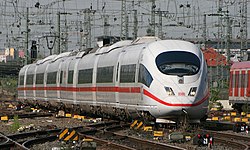Intercity Express
system of high-speed trains predominantly running in Germany and its surrounding countries From Wikipedia, the free encyclopedia
The Intercity-Express (abbreviated: ICE; sometimes stylized as InterCityExpress), is a category of high speed trains, which are operated by DB Fernverkehr since 1991. It is the highest service and fare category (Class A) of rail in Germany and the flagship train of the German state railway, Deutsche Bahn.[1] There are currently 259 trainsets in use.
 | |
 A German ICE 3 trainset | |
| Overview | |
|---|---|
| Locale | Germany, Netherlands, Belgium, Austria, Switzerland and France. Formerly Denmark. |
| Dates of operation | 1985–present |
| Predecessor | See History |
| Technical | |
| Track gauge | 1,435mm Standard gauge |
| Other | |
| Website | www |

High-speed lines for 300 km/h (186 mph)
High-speed lines for 250 km/h (155 mph) or more
Upgraded lines for 200–230 km/h (124–143 mph)
Conventional lines, often upgraded for 160 km/h (100 mph)
The trains have an operating speed of up to 300 km/h. They are one of fastest trains in the world. Some of the high-speed lines in Germany are:
- Cologne to Frankfurt am Main (up to 300 km/h)
- Nuremberg over Ingolstadt to Munich (up to 300 km/h)
- Hanover over Kassel to Würzburg (up to 250 km/h)
- Mannheim to Stuttgart (up to 250 km/h)
- Cologne to Düren (up to 250 km/h)
- Hannover to Berlin (up to 250 km/h)
- Hamburg to Berlin (up to 230 km/h)
There are other (upgraded) lines where the trains can reach 200 km/h. Some new high-speed lines are under construction, some are in planning.
ICE trains are also travelling to Austria, Belgium, Denmark, France, The Netherlands and Switzerland. Some of the destinations in other countries are: Aarhus, Brussels, Utrecht, Liege, Arnhem, Basel, Bern, Salzburg, Linz, Metz, Innsbruck, Amsterdam, Paris, Zürich and Vienna.
References
Wikiwand - on
Seamless Wikipedia browsing. On steroids.
